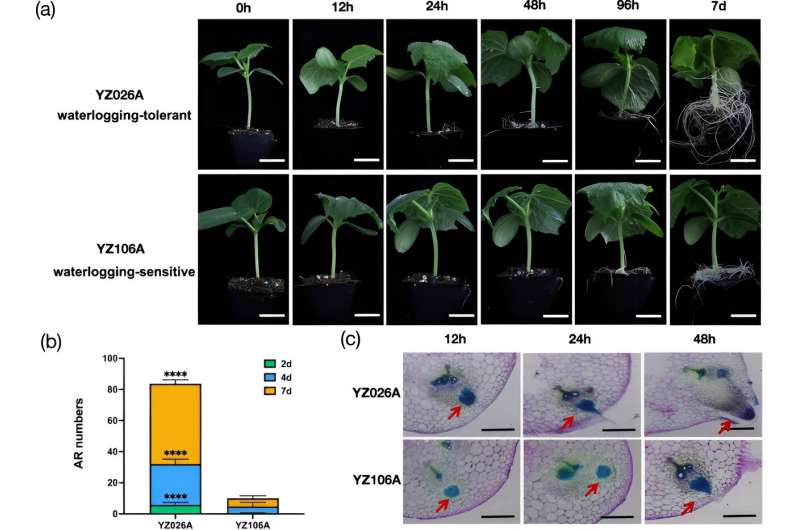This article has been reviewed according to Science X's editorial process and policies. Editors have highlighted the following attributes while ensuring the content's credibility:
fact-checked
peer-reviewed publication
proofread
Study uncovers genetic key to overcoming water stress in cucumbers

Waterlogged conditions, a consequence of heavy rainfall or inadequate drainage, disproportionately affect crops with delicate root systems like cucumbers. These conditions not only impede root respiration and plant development but also threaten agricultural productivity on a global scale.
As climate change intensifies the frequency and severity of such events, there is an urgent need to understand the genetic basis of waterlogging tolerance. This understanding is essential for developing crops that can withstand these harsh conditions, ensuring food security in a changing climate.
Yangzhou University's research team has unlocked a key genetic adaptation in cucumbers, a discovery that could redefine their resilience to waterlogging.
Their study, published in Horticulture Research, meticulously details how the CsPrx73 gene orchestrates a robust defense mechanism, including the promotion of adventitious roots and the scavenging of reactive oxygen species (ROS).
The study's comprehensive RNA-seq-based comparative transcriptome analysis has identified a complex network of 2616 differentially expressed genes (DEGs) that are responsive to waterlogging stress. The CsPrx73 gene, a standout among these, is central to the cucumber's adaptive response.
Overexpression of CsPrx73 in transgenic cucumber plants has been shown to significantly enhance the formation of adventitious roots, which are vital for the plant's survival in waterlogged conditions. Moreover, these plants exhibit an enhanced capacity for ROS scavenging, a critical defense mechanism against the oxidative damage induced by waterlogging.
The study further reveals the ERF transcription factor CsERF7-3's pivotal regulatory role, binding to the promoter of CsPrx73 and initiating its expression, thereby activating the plant's defense mechanisms against water stress. This intricate molecular dialogue presents a novel target for crop improvement strategies and provides a foundation for understanding the broader genetic responses to environmental stress.
Dr. Xuehao Chen, a corresponding author and a leading voice in horticulture at Yangzhou University, remarked, "The elucidation of the CsPrx73 gene's role is a significant stride in advancing our understanding of plant stress biology. This discovery could be instrumental in the strategic development of crops that exhibit superior resilience to waterlogging, a critical advancement for sustainable agriculture in the era of climate change."
The research holds profound implications for the future of agriculture, particularly in the realm of cucumber cultivation. By harnessing the power of the CsPrx73 gene, breeders are now empowered to cultivate new strains that are inherently resistant to waterlogging, potentially ensuring yield stability even in the most saturated conditions.
The broader application of these genetic insights could extend to a variety of crops, fortifying them against environmental stress and enhancing global food security in the face of escalating climate challenges.
More information: Jiawei Pan et al, RNA-seq-based comparative transcriptome analysis reveals the role of CsPrx73 in waterlogging-triggered adventitious root formation in cucumber, Horticulture Research (2024). DOI: 10.1093/hr/uhae062
Journal information: Horticulture Research
Provided by TranSpread





















